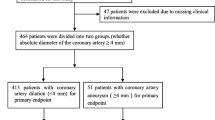Abstract
Kawasaki disease (KD) patients younger than 1 year of age are at especially high risk of developing coronary artery abnormalities (CAA). To define the clinical characteristics of this group, as well as the risk factors predisposing them to CAA, we reviewed the medical records of 136 KD patients younger than 1 year of age who were treated at the Korea University Medical Center from January 2001 to July 2006. Of these patients, 16 developed CAA (11.8%). The CAA(+) group had a longer duration of total fever than the CAA(−) group (9.1±3.7 days vs. 6.3±2.0 days, p=0.011), but did not differ in the duration of pre- and post-intravenous gamma-globulin (IVGG) fever. The CAA(+) group had fewer diagnostic symptoms than the CAA(−) group (2.7±1.1 vs. 4.3±1.2, p<0.001). Of the hematological findings, the CAA(+) group only differed from the CAA(−) group in having significantly higher total white blood cell (19.2±6.0 vs. 14.7±4.7 K/mm3, p=0.007) and platelet (462.9±101.0 vs. 383.6±121.1 K/mm3, p=0.014) levels. Multivariable logistic regression analysis showed that the only factors which were significantly associated with the development of CAA were the total number of symptoms (OR=0.493, 95% CI=0.293–0.829, p=0.007) and the duration of total fever (OR=1.405, 95% CI=1.092–1.808, p=0.008). Conclusively, incomplete clinical manifestations and a longer duration of total fever are significantly associated with the development of CAA in KD patients younger than 1 year of age. Therefore, these patients should be monitored for incomplete KD, especially if unexplained fever continues, and treatment to shorten the duration of total fever should be initiated.
Similar content being viewed by others
Abbreviations
- KD:
-
Kawasaki disease
- IVGG:
-
Intravenous gamma-globulin
- CAA:
-
Coronary artery abnormalities
- CRP:
-
C-reactive protein
- ESR:
-
Erythrocyte sedimentation rate
- BNP:
-
B-type natriuretic peptide
References
Anderson MS, Todd JK, Glodé MP (2005) Delayed diagnosis of Kawasaki syndrome: an analysis of the problem. Pediatrics 115(4):e428–e433
Ayusawa M, Sonobe T, Uemura S, Ogawa S, Nakamura Y, Kiyosawa N, Ishii M, Harada K; Kawasaki Disease Research Committee (2005) Revision of diagnostic guidelines for Kawasaki disease (the 5th revised edition). Pediatr Int 47:232–234
Belay ED, Maddox RA, Holman RC, Curns AT, Ballah K, Schonberger LB (2006) Kawasaki syndrome and risk factors for coronary artery abnormalities: United States, 1994–2003. Pediatr Infect Dis J 25(3):245–249
Burns JC, Glodé MP (2004) Kawasaki syndrome. Lancet 364(9433):533–544
Chang FY, Hwang B, Chen SJ, Lee PC, Meng CC, Lu JH (2006) Characteristics of Kawasaki disease in infants younger than six months of age. Pediatr Infect Dis J 25(3):241–244
Council on Cardiovascular Disease in the Young; Committee on Rheumatic Fever, Endocarditis, and Kawasaki Disease; American Heart Association (2001) Diagnostic guidelines for Kawasaki disease. Circulation 103(2):335–336
de Zorzi A, Colan SD, Gauvreau K, Baker AL, Sundel RP, Newburger JW (1998) Coronary artery dimensions may be misclassified as normal in Kawasaki disease. J Pediatr 133(2):254–258
Freeman AF, Shulman ST (2004) Refractory Kawasaki disease. Pediatr Infect Dis J 23(5):463–464
Genizi J, Miron D, Spiegel R, Fink D, Horowitz Y (2003) Kawasaki disease in very young infants: high prevalence of atypical presentation and coronary arteritis. Clin Pediatr (Phila) 42(3):263–267
Harada K (1991) Intravenous gamma-globulin treatment in Kawasaki disease. Acta Paediatr Jpn 33(6):805–810
Honkanen VE, McCrindle BW, Laxer RM, Feldman BM, Schneider R, Silverman ED (2003) Clinical relevance of the risk factors for coronary artery inflammation in Kawasaki disease. Pediatr Cardiol 24(2):122–126
Kim T, Choi W, Woo CW, Choi B, Lee J, Lee K, Son C, Lee J (2007) Predictive risk factors for coronary artery abnormalities in Kawasaki disease. Eur J Pediatr 166(5):421–425
Ministry of Health and Welfare (1984) Report of subcommittee on standardization of diagnostic criteria and reporting of coronary artery lesions in Kawasaki disease. Ministry of Health and Welfare, Tokyo, Japan
Mori M, Imagawa T, Yasui K, Kanaya A, Yokota S (2000) Predictors of coronary artery lesions after intravenous gamma-globulin treatment in Kawasaki disease. J Pediatr 137(2):177–180
Newburger JW, Takahashi M, Gerber MA, Gewitz MH, Tani LY, Burns JC, Shulman ST, Bolger AF, Ferrieri P, Baltimore RS, Wilson WR, Baddour LM, Levison ME, Pallasch TJ, Falace DA, Taubert KA; Committee on Rheumatic Fever, Endocarditis, and Kawasaki Disease, Council on Cardiovascular Disease in the Young, American Heart Association (2004) Diagnosis, treatment, and long-term management of Kawasaki disease: a statement for health professionals from the Committee on Rheumatic Fever, Endocarditis, and Kawasaki Disease, Council on Cardiovascular Disease in the Young, American Heart Association. Circulation 110(17):2747–2771
Omland T (2008) Advances in congestive heart failure management in the intensive care unit: B-type natriuretic peptides in evaluation of acute heart failure. Crit Care Med 36(1 Supp):S17–S27
Rosenfeld EA, Corydon KE, Shulman ST (1995) Kawasaki disease in infants less than one year of age. J Pediatr 126:524–529
Shulman ST, Rowley AH (2004) Advances in Kawasaki disease. Eur J Pediatr 163(6):285–291
Tseng CF, Fu YC, Fu LS, Betau H, Chi CS (2001) Clinical spectrum of Kawasaki disease in infants. Zhonghua Yi Xue Za Zhi (Taipei) 64(3):168–173
Witt MT, Minich LL, Bohnsack JF, Young PC (1999) Kawasaki disease: more patients are being diagnosed who do not meet American Heart Association criteria. Pediatrics 104(1):e10
Yanagawa H, Nakamura Y, Yashiro M, Uehara R, Oki I, Kayaba K (2006) Incidence of Kawasaki disease in Japan: the nationwide surveys of 1999–2002. Pediatr Int 48(4):356–361
Author information
Authors and Affiliations
Corresponding author
Additional information
An erratum to this article can be found at http://dx.doi.org/10.1007/s00431-009-1045-6
Rights and permissions
About this article
Cite this article
Yeo, Y., Kim, T., Ha, K. et al. Incomplete Kawasaki disease in patients younger than 1 year of age: a possible inherent risk factor. Eur J Pediatr 168, 157–162 (2009). https://doi.org/10.1007/s00431-008-0722-1
Received:
Revised:
Accepted:
Published:
Issue Date:
DOI: https://doi.org/10.1007/s00431-008-0722-1



